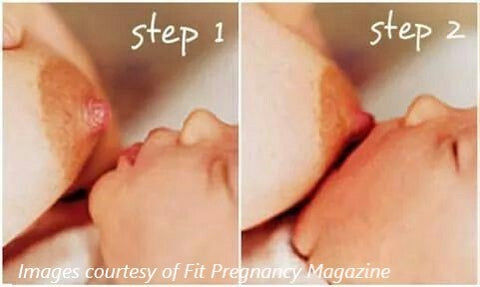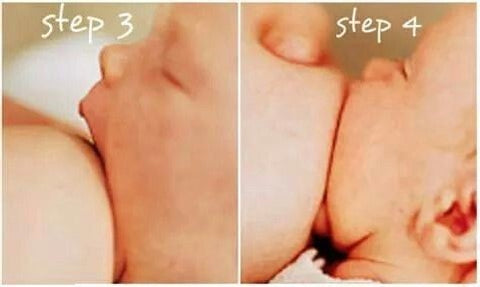A fundamental technique for breastfeeding success is the latch.
In order to get milk from the breast, the baby must latch onto the breast. The word "latch" describes the way a baby takes the breast into his/her mouth. The better the latch, the more easily the baby gets mother's milk. The following "deep latch technique" can help your baby feed more easily. It can also prevent damaged and sore nipples.
4 Steps to a Deep Latch
-
Hold your breast with your thumb and index finger on the edge of the areola forming a "C" (football hold), or a "U" (cross cradle hold). Squeeze the finger and thumb toward each other to compress the breast. Keep your fingers off to the side forming "half a sandwich" or just "pinching an inch".
-
When putting the baby to the breast, support your baby's head with one hand, thumb near one ear, third finger near the other ear, with the web of your hand at the nape of your baby's neck. Tip the head slightly backwards by lifting between your baby's shoulder blades with the heel of your hand.

- With your baby's head tilted back and chin up, lift him or her to touch your nipple. The nipple should rest just above the baby's upper lip. Wait for your baby to open very wide, then "scoop" the breast by placing the lower jaw on first. Now tip your baby's head forward and place the upper jaw well behind your nipple. Keep your thumb pressing down to form the flattened sandwich as you place your baby's upper jaw behind the nipple. The lower jaw will be more deeply positioned then the upper jaw.
- Wait several seconds, then release your breast. If your baby's nose is buried deeply in the breast, tip the head slightly so you can see your baby's nostril while the nose still touches the breast. There is no need to continue pressing the breast with your thumb.

Two More Tips:
First, all babies have receded chins. If your baby's head drops forward, he/she cannot get the lower jaw correctly positioned deeply under the areola. This results in pinched, sore, blistered, scabbed, nipples and the possibility of poor milk flow.
Second, the deep latch can be achieved with any position of the baby: "football", "cradle", or "cross-cradle" holds, but it is easier if you sit up straight and use pillows to support you and your baby.
Remember: It's not supposed to hurt to breastfeed.
Sore nipples almost always mean your baby needs to be latched on more deeply. Watch our Deep Latch Video Here!
Why is Breastfeeding Important? Read More ...
Is your baby getting enought to eat? Click here
Concerned about plugged ducts and/or mastitis? See our tips here
Breastfeeding and Thrush: We answer your questions here
When should I offer a breastfed baby a bottle? Click to read
Breastfeeding tips for the working mother: Read this
Check out more of our great Breastfeeding Help Library here
Copyright ©2024 by The Pump Station & Nurtury®. All rights reserved. No part of this may be reproduced in any form without permission from The Pump Station. This article has not been prepared by a physician, is not intended as medical advice, and is not a substitute for regular medical care. Consult with a physician if medical symptoms or problems occur. Revised 11/2024























